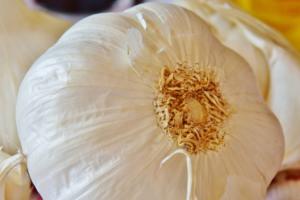Garlic (Allium sativum)
A superfood with many uses and benefits
Often, we look far and wide to other countries for superfoods when instead we should be looking in our backyard. Garlic is easy to grow, affordable to buy, and can be used in many ways.
Garlic is known to prevent cancer, CVD, respiratory issues, and fight infections.
Much of this is thanks to the rich sulfur content in garlic (Jones, n.d.). Garlic also shows promise for dementia and atherosclerosis (Jones, n.d.).
Garlic is one powerful food that you can find worldwide, with United States, China, South Korea, and Spain as the top producers (Murray et al., 2005). Most of the U.S. garlic is from California (Wood, 2010). However, it is native to Asia and is one of the oldest cultivated plants in the world (Murray et al., 2005). Sanskrit records indicate that garlic has been used for over 5,000 years, while the Chinese have been using it for at least 3,000 years (Murray et al., 2005).
However, it is no longer found in the wild since it has been cultivated for so long. Today, you can grow your garlic using just one clove. One clove planted in the fall or spring will yield one bulb (Wood, 2010).
The Benefits of Sulfur
Garlic contains sulfur-containing compounds, one you may be familiar with, called allicin. But it also contains other sulfur-rich compounds. In fact, there are six categories of sulfur-containing compounds in garlic. Allicin is within the thiosulfinates category (WHF, n.d.)
Sulfur plays a role in detoxification and is good for our joints and connective tissue (WHF, n.d.).
Buying garlic
Please do not buy it already minced in the jar. Buy only fresh garlic, organic preferably. Choose ones that are plump with unbroken skin. Avoid bulbs if you see them starting to sprout or looks dry or dark.
While garlic powder is also more convenient, you will not reap the same benefits as fresh garlic.
Store garlic away from sunlight. A bulb can stay fresh for several weeks and up to two months, but once you break off a clove, the rest of the bulb will have a much shorter shelf life-closer to one week. (Murray et al., 2005; Wood, 2010).
How to Grow Garlic (Indoors)
- Purchase organic locally grown garlic so that you are using the best variety to grow in your area of the country.
- Place the cloves that you will use in the fridge for several weeks.
- You can grow garlic in a small flowerpot but make sure it has drainage holes on the bottom. Fill the pot with potting soil.
- Place a clove pointy side up with the papery skin still intact and plant it about three inches down in the soil and cover with soil.
- Plant one clove per small flowerpot. If it is a large pot you can add in more cloves and allow enough space for the bulbs to form.
- Be patient. If you are growing this indoors, it can take 7-9 months for your bulbs to be ready to harvest. When the end of the green tops or leaf shoots begin to turn yellow or brown or the leaves begin to fall over, you know it is time to harvest soon-typically within a couple of weeks when all the shoots have changed color.
- Grow garlic in a sunny spot as they prefer a lot of sunlight. Ideally at least 6 hours per day. They also do well with fertilizer and compost added to the soil.
Raw Garlic
Raw and aged garlic have different benefits. Incorporate both into your diet.
To reap raw garlic benefits, chop or crush the garlic to stimulate the enzymatic process that converts alliin into allicin (Murray et al., 2005). Allicin is also the compound that is responsible for garlic odor. (Murray et al., 2005)
While Worlds Healthiest Foods (n.d.) states that you need to consume six garlic cloves one to three times weekly for health benefits, Rakel (2018a) says that garlic, in the dose of one-half clove to two cloves per day in raw form, can contribute to health benefits. Raw garlic can be added to salad dressings, to whole grain dishes such as a quinoa tabouleh, and thus is versatile and easy to add into daily meals.
Mashed garlic will be more potent than just slicing it a few times. This is because you want more of the cells exposed to oxygen (Wood, 2010). The exposed cells release sulfides that oxidize in contact with the air (Wood, 2010).
Aged Garlic
Did you know that raw garlic is antimicrobial, but aged garlic is not? However, aged garlic is supportive of heart health.
Did you also know that you can easily make aged garlic rather than spending money on it in supplement form?
Aged garlic is an affordable option that one can create at home in their slow cooker, rice cooker, or in a mason jar with apple cider vinegar instead of having to purchase it in supplement form (Kellogg Garden, n.d., The Natural Man, 2017). These two sites I sourced have simple instructions on how to do so.
Human and animal studies have shown aged garlic and powdered garlic to be supportive of reducing BP (Rakel, 2018; Reid, 2016). Garlic may reduce HTN by enhancing the regulation of nitric oxide, which will cause smooth muscle relaxation, blood vessel dilation, and BP reduction (Reid & Fakler, 2014). Garlic is affordable, safe with BP medications (Reid & Fakler, 2014), easy to incorporate, and can be taken in supplement form. However, monitor your BP when on drugs and adding in garlic supplementation.
The additional benefit of aged garlic is that it does not have the odor or smell that raw garlic has, and thus one does not have to worry about garlic breath.
While raw garlic has many benefits due to the allicin content in the chopped, natural state, aged garlic has antiglycation activity due to the organosulfur compounds (Elosta et al., 2017). The organosulfur components are potent antioxidants that will not be found in raw form (Elosta et al., 2017).
Some studies reviewed used garlic powder, and others used aged garlic, both showing positive results in a meta-analysis for HTN, cholesterol, and immunity (Ried, 2016). This is interesting since others such as Worlds Healthiest Foods (n.d.) state that garlic powder is not as potent for therapeutic use. I suggest using aged garlic by making your own or buying in supplement form for health benefits and reserve the garlic powder for when in a pinch when cooking.
Garlic Benefits
- Protective against atherosclerosis
- Protective against CVD
- Can decrease total cholesterol.
- Can improve HDL cholesterol.
- Can reduce high BP.
- Has antibacterial, antiviral, and anti-fungal properties.
- Can be effective against colds, flu, candida, other viruses.
- Offers cancer protection.
- Can improve digestion.
- Can use garlic ear oil for ear infections.
- Can assist with toxin elimination.
(Murray et al., 2005; Wood, 2010)
Ways to Incorporate Garlic Into Your Diet:
- Add raw garlic to any type of dressing for your salads. Add it to oil and vinegar dressings but it can be mixed with mayonnaise dressing, ranch dressing, etc.…
- Add to mashed potatoes.
- Add to hummus, dips, and spreads.
- Add to lightly cooked vegetable dishes.
- Add to pasta sauces, marinades, stir fry’s
How Much to Consume to Reap Benefits?
Twenty grams of garlic sourced from fresh bulbs one to three times per week will translate into measurable health benefits (WHF, n.d.). This equates to 6 cloves of garlic to get roughly 20 grams depending on the size of the cloves. Rakel (2018) states that one only needs to consume 1-2 cloves daily to reap benefits for HTN. Thus, due to the differences, more research is needed to determine the exact amount needed for specific health issues.
Who Should Avoid Consuming Garlic
If you are having menopausal hot flashes or feeling excessive heat during menopause, you may want to avoid it.
During pregnancy, please do not go too heavy on garlic use since it can stimulate the uterus (Wood, 2010).
It is said that garlic can aid in jet lag. Eat garlic or take in supplement form for several days before the trip, the day of the journey, and a full day after arriving at your destination (Wood, 2010).
Bottom Line
Consume aged garlic, lightly cooked, and raw garlic to reap its vast health benefits. It is affordable, safe, and easy to grow.
Want more helpful nutrition information, tips, and recipes that you won’t find elsewhere? Sign up for my substack.
https://trufoods.substack.com
References
Elosta, A., Slevin, M., Rahman, K., & Ahmed, N. (2017). Aged garlic has more potent antiglycation and antioxidant properties compared to fresh garlic extract in vitro. Scientific reports, 7, 39613. https://doi.org/10.1038/srep39613
Jones, S. (n.d.). Super foods. https://ahha.org/selfhelp-articles/super-foods/
Kellogg Garden. (n.d.). How to make organic black garlic at home. https://www.kellogggarden.com/blog/gardening/how-to-make-organic-black-garlic-at-home/
Murray, M., Pizzorno J. & Pizzorno, L. (2005). The encyclopedia of healing foods. (pp. 201-203). Atria Books.
Rakel, D. (2018a). Chapter 24. Hypertension. In Integrative medicine (4th ed.). (pp. 230-241). Elsevier.
Ried, K. (2016). Garlic Lowers Blood Pressure in Hypertensive Individuals, Regulates Serum Cholesterol, and Stimulates Immunity: An Updated Meta-analysis and Review. The Journal of Nutrition, 146(2), 389S-396S. 10.3945/jn.114.202192
Ried, K., & Fakler, P. (2014). Potential of garlic (Allium sativum) in lowering high blood pressure: mechanisms of action and clinical relevance. Integrated blood pressure control, 7, 71–82. https://doi.org/10.2147/IBPC.S51434
The Natural Man. (2017). How to make ages garlic: The benefits of garlic without the odor. http://www.thenaturalman.net/2017/02/09/make-aged-garlic/
Wood, R. (2010). The new whole foods encyclopedia. (pp. 150-152). Penguin Books.
Worlds Healthiest Foods. (n.d.). Garlic. https://whfoods.com/genpage.php?tname=foodspice&dbid=60




